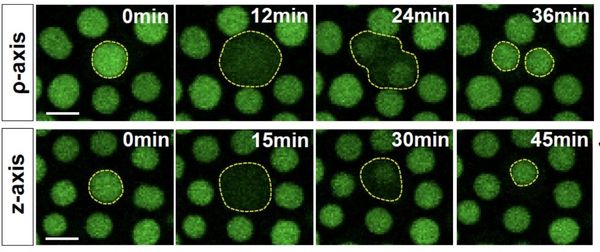Research
Video credit: Sarah Deng
Using Mammalian and Fruit Fly Models
Studying how cell junctions contribute to tissue formation and maintenance
Our bodies are composed of millions of cells that require special large multi-protein complexes to allow them to attach to each other and the extracellular matrix to form 3-dimensional shapes. Integrins are the main molecules in the human body that link cells to the extracellular matrix (ECM), a mixture of complex sugars and proteins that form the base upon which tissues are built. Integrins are very important for many processes and disruptions in integrin function are associated with a large array of disease processes in humans. We are interested in understanding the mechanisms by which integrins carry out their diverse functions as this will give us crucial insight into many disease processes.
To understand how integrins carry out so many diverse functions we are focusing on how they are regulated, that is switched on and off at certain times. Our proposal presents experiments that seek to understand how integrins are regulated and how this regulation contributes to tissue formation and repair. We use flies as a pipeline to quickly identify using genetic approaches regulatory mechanisms that control integrin-based adhesion to the ECM. Next, we introduce the most interesting mutations we identify in our fly work into mice. These mutations up or down-regulate integrin-based adhesion and reveal how integrin regulation contributes to diverse processes. In particular, the lab focuses on integrin regulation in fibroblasts, specialized cells that are important for tissue repair, and melanocytes. Results of this study will shed important light on how integrins are controlled during tissue formation and maintenance, and also provide insight into how dysregulation of integrin function leads to disease.

Studying how cell junctions help regulate blood progenitors
As a model for how stem cells are regulated by cell junctions, we are studying blood development in the fly:
Stem cells are essential for animal development and allow the maintenance and regeneration of tissues. Stem cells retain the capability to divide and develop into many types of adult cells throughout the lifetime of an organism. The blood stem cells in humans and animals are particularly important for fighting infections as they produce the immune cells required to fight infection. The work we propose seeks to understand the mechanisms that regulate the activation of blood stem cells such that they produce immune cells upon infection. Our work focuses on the role played by the blood stem cell’s environment in regulating this transition. In particular, we will focus on the role of various cell junctions in shaping the signals that control stem cell behaviour. We propose that in response to infection, the stem cell environment changes in very specific ways and that this induces the activation of blood stem cells. Understanding the mechanisms that induce blood stem cell activation upon infection will help us gain insight into what happens in diseases that affect the blood stem cell niche such as leukemia and autoimmune diseases.
Image from: https://elifesciences.org/articles/84085

Studying how cell junctions help regulate germline and somatic stem cells
Spermatogenesis produces one of the most specialized and architecturally complex cells in animals and is a dynamic developmental process wherein the germline undergoes 3 controlled morphogenetic transitions between discrete stages: from mitotic spermatogonia to meiotic spermatocytes, from meiotic spermatocytes to spermatids, and from spermatids to mature spermatozoa. We employ genetic approaches to investigate the developmental program of spermatogenesis. To date, the precise role of the soma in mediating the developmental program of spermatogenesis has not been systematically explored. To address this we recently carried out a large genetic screen to identify genes that are required in the somatic cells of Drosophila testis for sperm development. Our lab uses the fly testes as a model since they provide an excellent genetically tractable in vivo model system to explore spermatogenesis. In addition to characterizing genes identified in our screen, our recent work has focused on the role of gap junctions in allowing the soma and germline to communicate during sperm morphogenesis.
Image credit: Dr. Michael Fairchild
The lymph gland of drosophila is the hematopoietic organ of the fly. In this movie, the niche is labelled in green w/ red nuclei. You can see how it sits on top of the lymph gland (blue nuclei). The niche controls the production of mature blood cells.
Video credit: Dr. Kevin Ho
These communication "hotspots" form over the course of tissue development, and are dependent on the movement of Ca+2 ions through gap-junctions between adjacent cells.
Video credit: Dr. Kevin Ho
This website uses cookies.
We use cookies to analyze website traffic and optimize your website experience. By accepting our use of cookies, your data will be aggregated with all other user data.